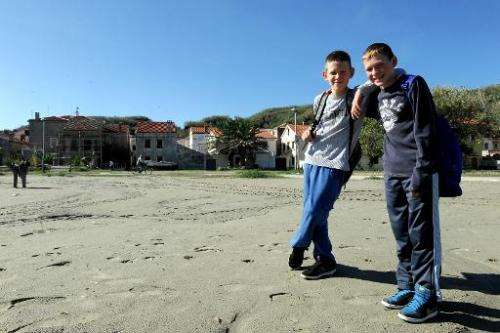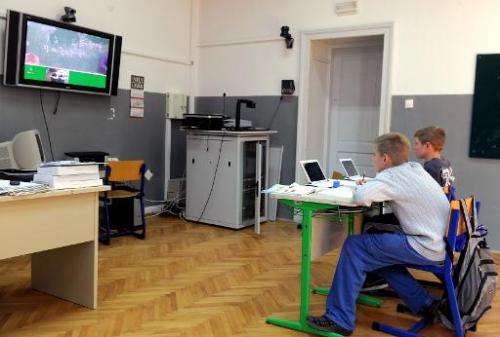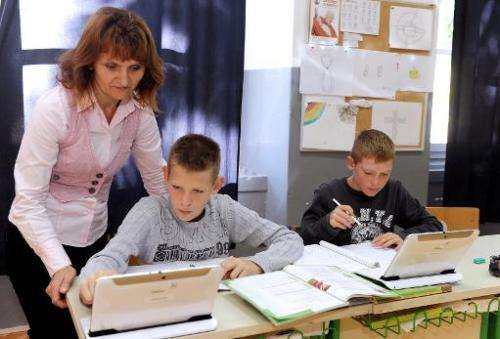Dominik Malovic (L) and Ivan Macic (R) posing on beach near their school on the small remote island of Susak in Croatia's northern Adriatic, October 18, 2013
For Croatia, making sure the five children on the tiny island of Susak get good schooling is not only a civic responsibility, it's a way of ensuring the viability of its sparsely populated Adriatic islands.
"Schools give life to small islands," said Olivela Franko, the elementary school principal on the larger Losinj island who coordinates an "e-learning" network that links island schools in the area.
"There are not that many children but we will not allow them to disappear. We try everything so they don't feel like they are living at the end of the world," she said.
In all, 66 of the Balkan state's 1,200 islands, islets and rocks off its Adriatic coast are today inhabited, and home to 20 or so working schools.
Though isolated in the winter, they are a tourist magnet in the summer when visitors flock to enjoy their unspoiled nature, blue harbours and cheaper rates than inside the eurozone .
Though many of the islands once thrived on wine-making they emptied out in the last century. Residents left to find work after disease devastated vineyards, others fled the old Yugoslav communist regime—most emigrating to the United States.
Susak was typical. In its mid-20th century heyday, it counted 2,000 inhabitants, with more than 100 pupils and up to six teachers.
Today, only 150 people—including the five children —live year-round on this car-free bit of land three kilometres (two miles) long and 1.5 kilometres wide in the northern Adriatic.
Most are elderly, living off their pensions or from fishing, farming or the critical tourism sector.
A regular ferry is the only link with nearby Losinj and the mainland and often unable to dock in winter because of bad weather.
On Susak, as in most island schools, a single teacher is in charge of compulsory primary education, until children move to Losinj or the mainland for secondary school.
Dominik Malovic (L) and Ivan Macic (R) studying in their school on the small remote island of Susak in Croatia's northern Adriatic, October 18, 2013
"When I stepped into this classroom 25 years ago, I had only a sponge, a piece of chalk and 11 children of different ages," recalled Susak's teacher Barbara Busic-Ribaric, whose five pupils are aged between eight and 14.
"I was unsure whether I would make it," the 48-year-old said.
Five years ago, her school was brought into the online project called "E-islands" that links the remote classrooms to improve schooling and head off further emigration by islanders.
The project is part of a larger government bid that invests 150 million euros annually to improve infrastructure and revitalise the Adriatic islands, considered a key part of Croatia's historical and cultural heritage.
On Susak, with its 19th-century lighthouse and maze of narrow, winding streets with a post office, two shops and a church, the school has been newly renovated—with more than enough space these days so local harbour authorities occupy the upper storey.
For "E-Islands" coordinator Franko, the e-learning not only "develops children's computer skills" but "makes them feel a part of the (larger) class and helps their socialisation for later, when they go on to secondary education."
Susak's two 12-year-olds, best friends Dominik Malovic and Ivan Macic, wave to peers on other islands as they sit in front of a video screen for math class.
"I adore playing by the sea, there are no cars so we are free to go wherever we want to!" said Dominik . He and Ivan feel the island belongs to them after the summer season, when seagulls swarm its fine grey sandy beaches instead of noisy tourists.
Dominik boasts "dozens of friends on Facebook" and "it is so cool to get connected and see them," but said "there is no chance that I would switch for a larger class."
"It would be too crowded and too noisy," Ivan agreed.
'Like family'
Their teacher warns that despite modern technology the children lack competition but her pupils seem not to mind, except for the shortage of playmates.
"I miss other kids a bit! I could play better," said 10-year-old Mia Loncar, stepping off a boat returning from Losinj.
Teacher Barbara Busic-Ribaric (C) helps pupils Dominik Malovic (L) and Ivan Macic (R) at their school on the small remote island of Susak in Croatia's northern Adriatic, October 18, 2013
Teacher Busic-Ribaric at times regrets the island's isolation.
Because of bad weather, her pupils could not attend this year's "Bread Day" on Losinj, an annual event across Croatia when children learn about bread-making. "We sent our buns a day earlier, but unfortunately we had to stay" on Susak, she said.
But such regrets fade quickly, she said, saying her pupils often visit her at home. "We are like family."
For Ivan, they are a team.
"The teacher and I, we are the best basketball team! We beat all the others!" he said proudly.
© 2014 AFP
























